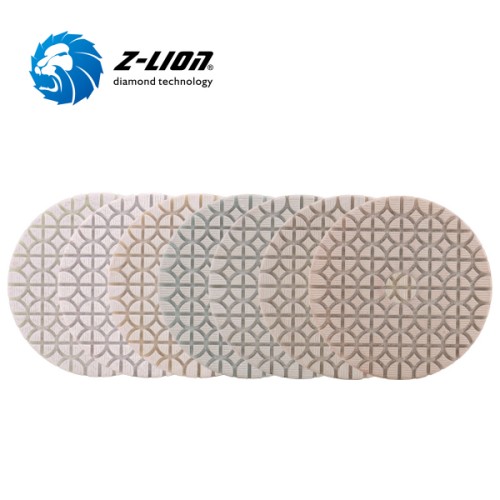How to Choose Polishing Pad for Your Surface Preparation Needs?
Polishing pads are indispensable tools for high-quality polishing, grinding, and stain removal. Whether you're into automotive detailing, woodworking, or industrial finishing, choosing the right polishing pad is crucial to achieving the desired finish while ensuring efficiency and durability. In this article, we’ll explore the basic factors to consider when selecting a polishing pad, focusing on product construction and performance specifications.

Product structure: three-layer structure
Polishing pads typically have a three-layer construction, with each layer having unique features that are critical to its performance and longevity.
Surface: The surface of a polishing pad is the component that interacts directly with the surface being treated. This layer must be soft, wear-resistant, and easy to replace. The softness of the surface layer ensures smooth and even contact with the workpiece, minimizing the risk of scratches and swirl marks. Additionally, high wear resistance extends brake pad life, reduces replacement frequency, and improves overall cost-effectiveness. Easy to replace, gaskets can be replaced quickly and efficiently, promoting uninterrupted workflow.
Middle layer: The middle layer of the polishing pad plays a vital supporting role and should have a certain hardness and thickness. This layer helps improve the overall stability and rigidity of the polishing pad, ensuring consistent pressure distribution during polishing. A sufficiently thick and elastic middle layer helps maintain the shape and integrity of the pad, especially when subjected to varying degrees of pressure and friction during use.
Backer Pad: The bottom layer serves as the connecting component of the polishing pad and is connected to the back plate of the tool. The bottom layer must have anti-slip and shock-proof properties to improve stability and safety during operation. Anti-slip properties promote a secure connection to the back panel, minimizing the risk of slipping or shifting during use. In addition, anti-vibration features help minimize vibration, giving operators a more controlled and comfortable work experience.
Performance Specifications: Meet application requirements
In addition to product construction, it is critical to match the performance specifications of the polishing pad to the specific requirements of the application. Key considerations include:
Abrasives: Different materials require different abrasive compositions for optimal performance. Whether metal, stone, or composite materials, choosing the right abrasive (such as foam, microfiber, or diamond) ensures effective material removal and surface refinement.
Grit Size: The grit size of the polishing pad determines the degree of surface wear and the final finish. Finer abrasive sizes are good for achieving a smooth, high-gloss finish, while coarser abrasives excel at material removal and smoothing out rough surfaces.
Compatibility: Make sure the polishing pad you choose is compatible with your polishing equipment and backing plate to avoid operational issues and maximize efficiency. Compatibility considerations extend to the type of polisher and the specific connection mechanism employed.
Product advantages
Improve work efficiency: One of the main advantages of using a polishing pad is its ability to significantly increase work efficiency. The specialized design and composition of polishing pads allow for smoother, more consistent material removal, simplifying the surface preparation process. By promoting faster wear and refinement, polishing pads significantly increase labor productivity by reducing the time and effort required to achieve the desired finish. This increased efficiency means faster project schedules and optimized resource allocation, ultimately benefiting overall operational output.
Cut costs: While improving work efficiency, polishing pads also offer compelling advantages by reducing costs. Using a polishing pad is a more economical solution than alternative surface preparation methods such as sanding or grinding. Reduced labor intensity and faster task completion result in lower labor costs, while the reduced need for extensive material removal helps minimize material consumption. Additionally, the longevity and reusability of high-quality polishing pads help extend their lifespan, resulting in significant cost savings over time.
Improve product quality: The pursuit of superior product quality finds an ally in polishing pads, which excel at delivering a consistent and refined finish. The precise action of the polishing pad results in a smoother, flatter, and highly uniform surface. This surface refinement not only contributes to aesthetic appeal but also has an impact on functional performance and product durability. Furthermore, the improved quality of the treated surface has a positive impact on the overall value and market appeal of the finished product, thereby increasing customer satisfaction and loyalty.
Environmental protection and safety: In addition to functional benefits, polishing pads promote environmental responsibility and safety in surface preparation applications. Unlike some traditional surface preparation methods that may generate sparks or produce excessive noise, using a polishing pad features a relatively quiet and spark-free operation. This attribute contributes to a safer, greener work environment, reducing the risk of hazards and minimizing the impact on surrounding ecosystems. The absence of sparks and reduced noise levels not only safeguards worker well-being but is also consistent with sustainable and responsible manufacturing practices.
-
Online service
-
Official wechat account

-
QQ:40933769
-
E-mail:sales@z-lion.com
Online Message
Please feel free to give your inquiry in the form below. We will reply you in 24 hours.

